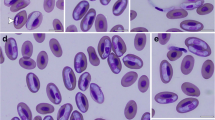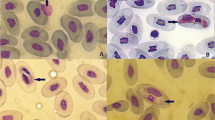Abstract
Hepatozoon spp. are the most frequent intracellular protozoa in snakes. Considering the variety of parasites infecting specimens of Caudisona durissa terrifica and the divergent data in literature where only two species, Hepatozoon romani and Hepatozoon capsulata, are described, the aim of this study was to morphologically, morphometrically, and molecularly characterize Hepatozoon spp. from some naturally infected specimens of C. durissa terrifica, and observe changes caused by these protozoa in parasitized erythrocytes. Four snakes were examined. Two of them had two morphological distinct gamonts, while the other two had only one type of gamont. The six distinct gamonts were provisionally named gamonts A, B, C, D, E, and F. Statistical analysis, however, confirmed the existence of only four parasite populations, those which were capable of inducing significant alterations in determined red blood cells variables. Attempts to infect Aedes aegypti and Culex quinquefasciatus mosquitoes were done for each snake specimen. Some mosquitoes became infected and oocysts were recovered and measured. The detection of Hepatozoon DNA was obtained with success but the molecular characterization was unable to differentiate species of the samples, with respect to the fragment studied.




Similar content being viewed by others
References
Ball GH (1970) Hemogregarine life cycles. J Parasitol 56:17
Ball HG, Chao J, Telford SR Jr (1967) The life history of Hepatozoon rarefaciens (Sambon & Seligman, 1907) from Drymarchon corais (Colubridae), and its experimental transfer to Constrictor constrictor (Boidae). J Parasitol 53(5):897–909
Bashtar AR, Boulos R, Melhorn H (1984a) Hepatozoon aegypti nov. sp. 1. Life cycle. Parasitol Res 70(1):29–41
Bashtar AR, Ghaffer FA, Melhorn H (1984b) Hepatozoon aegypti nov. sp. 3. Electron microscope studies on gamogony and sporogony inside the vector Culex pipiens molestus. Parasitol Res 70(1):53–65
Bashtar AR, Ghaffer FA, Shazly MA (1991) Life cycle of Hepatozoon mehlhorni sp. nov. in the viper Echis carinatus and the mosquito Culex pipiens. Parasitol Res 77(5):402–410
Baneth G, Barta JR, Shkap V, Martin DS, Macintire DK, Vincent-Johnson N (2000) Genetic and antigenic evidence supports the separation of Hepatozoon canis and Hepatozoon americanum at the species level. J Clin Microbiol 38:1298–1301
Consoli RA, Oliveira RL (1994) Principais mosquitos de importância sanitária no Brasil, 1ath edn. Editora Fiocruz, Rio de Janeiro
De Biasi P, Pessoa SB, Vieira FCG (1972) Nota sobre longa latência de infecção por Hemogregarina em uma serpente peçonhenta: Boothrops moojeni Hoge, 1965. Atas Soc Biol Rio de Janeiro 15:71–73
Desser SS, Hong H, Martin DS (1995) The life history, ultrastructure, and experimental transmission of Hepatozoon catesbianae N. Comb., an apicomplexan parasite of the Bullfrog, Rana catesbeiana and the mosquito, Culex territans in Algonquin Park, Ontario. J Parasitol 81:212–222
Harris DJ, Maia JPMC, Perera A (2011) Molecular characterization of Hepatozoon species in reptiles from the Seychelles. J Parasitol 97:106–110
Inokuma H, Okuda M, Ohno K, Shimoda K, Onishi T (2002) Analysis of the 18S rRNA gene sequence of a Hepatozoon detected in two Japanese dogs. Vet Parasitol 106:265–271
Jefferies R, Ryan UM, Muhinickel CJ, Irwin PJ (2003) Two species of canine Babesia in Australia: detection and characterization by PCR. J Parasitol 89:409–412
Lainson R, Paperna I, Naiff RD (2003) Developement of Hepatozoon caimani (Carini, 1909) Pessôa, De Biasi & De Souza, 1972 in the Caiman Caiman c. crocodilus, the frog Rana catesbeiana and the mosquito Culex fatigans. Mem Inst Oswaldo Cruz 98:103–113
Maia JPMC, Harris DJ, Perera A (2011) Molecular survey of Hepatozoon species in lizards from North África. J Parasitol 97:513–517
Moço TC, O'Dwyer LH, Vilela FC, Barrella TH, Silva RJ (2002) Morphologic and morphometric analysis of Hepatozoon spp. (Apicomplexa, Hepatozoidae) of snakes. Mem Inst Oswaldo Cruz 97:1169–1176
Navajas M, Lagnel J, Fauvel G, De Moraes G (1999) Sequence variation of ribosomal internal transcribed spacers (ITS) in commercially important Phytoseiidae mites. Exp Appl Acarol 23:851–859
O'Dwyer LH, Lopes VVAH, Rubini AS, Paduan KS, Ribolla PEM (2009) Babesia spp. infection in dogs from rural areas of São Paulo State, Brazil. Rev Bras Parasitol Vet 18(2):23–26
O'Dwyer LH, Moço TC, Silva RJ (2003) Description of the gamonts of a small species of Hepatozoon sp. (Apicomplexa, Hepatozoidae) found in Crotalus durissus terrificus (Serpentes, Viperidae). Parasitol Res 92(2):110–112
O'Dwyer LH, Silva RJ, Madeira NG (2011) Description of gamontogonic and sporogonic stages of Hepatozoon spp. (Apicomplexa, Hepatozoidae) from Caudisona durissa terrifica (Serpentes, Viperidae). Parasitol Res 108:845–851
Pessoa SB, De Biasi P (1972) Esporulação no Culex dolosus (L. Arribálzaga, 1891), do Hepatozoon roulei (Phisalix & Laveran, 1913), parasita da Bothrops alternatus (D. & B.,1854), transfundido com o sangue na Bothrops moojeni Hoge, 1965. Mem Inst Butantan 36:241–245
Pessoa SB, De Biasi P (1973a) Considerações taxomômicas sobre cistos esquizogônicos e sobre gametócitos de Hepatozoon (Sporozoa, Haemogregarinidae) parasitas de serpentes brasileiras. Mem Inst Butantan 37:291–298
Pessoa SB, De Biasi P (1973b) Nota taxonômica sobre cistos esporogônicos de algumas espécies de Hepatozoon (Sporozoa, Haemogregarinidae) parasitas de serpentes brasileiras. Mem Inst Butantan 37:299–307
Pessoa SB, De Biasi P (1974) Nota sobre a formação de cistos esporogônicos de Hepatozoon sp., parasita da Leimadophis poecilogyrus (Wied.), (Serpentes: Colubridae) em sanguessuga experimentalmente infectada. Rev Pat Trop 3(2):221–224
Pessoa SB, Belluomini HE, Souza DM (1971a) Notas sobre hemogregarinas de serpentes brasileiras XIV – Esporogonia da hemogregarina da Bothrops moojeni Hoge, 1965 no Culex (Culex) dolosus (L. Arribálzaga, 1891). Arq Inst Biol 38(4):253–258
Pessoa SB, Cavalheiro J, Souza DM (1970a) Notas sobre hemogregarinas de serpentes brasileiras XII – hemogregarinas de serpentes do gênero Corallus. Arq Inst Biol 37(3):205–211
Pessoa SB, Cavalheiro J, Souza DM (1970b) Notas sobre hemogregarinas de serpentes brasileiras XIII – Evolução esporogônica da Hemogregarina da Thamnodynastes strigatus (Colubridae). Arq Inst Biol 37(3):213–217
Pessoa SB, De Biasi P, Puorto G (1974a) Nota sobre a prevalência de hemoparasitas em serpentes do Brasil. Mem Inst Butantan 38:68–118
Pessoa SB, De Biasi P, Puorto G (1974b) Transferência do Hepatozoon tupinambis parasita do lagarto Tupinambis teguixin, para a serpente cascavel (Crotalus durissus terrificus) por intermédio de mosquito Culex fatigans. Mem Inst Oswaldo Cruz 72:295–299
Pessoa SB, De Biasi P, Sacchetta L (1974c) Evolução de Hepatozoon sp. parasita do Leptophis ahaetulla (Linnaeus) (Serpentes, Colubridae) no Culex fatigans. Mem Inst Butantan 38:119–122
Pessoa SB, Sacchetta L, Cavalheiro J (1970c) Notas sobre hemogregarinas de serpentes brasileiras X- Hemogregarinas da Hydrodynastes gigas. (Duméril et Bibron) e sua evolução. Rev Lat Amer Microbiol 12:197–200
Pessoa SB, Sacchetta L, Cavalheiro J (1971b) Notas sobre hemogregarinas de serpentes brasileiras XV. Sobre uma nova espécie do gênero Haemogragarina (S.S.) parasita de Thamnodynastes pallidus nattereri (Thumberg) e sua evolução em mosquitos. Rev Lat Amer Microbiol 13:29–32
Phisalix M (1931) Les hémogrégarines de Crotalus terrificus Lau. Bull Soc Path Exot 24:190–194
Rubini AS, Paduan KS, Ribeiro VC, Ribolla PEM, Silva RJ, O'Dwyer LH (2005) Caracterização Molecular de Hepatozoon sp. (Apicomplexa, Hepatozoidae) em Hydrodynastes gigas (Serpente, Colubridae). In: Congresso Brasileiro de Herpetologia, 2, 2005, Belo Horizonte. Anais…Belo Horizonte: Minas Gerais
Schlegel M (1991) Protist evolution and phylogeny as discerned from small subunit ribosomal RNA sequence comparisons. Eur J Parasitol 27:207–219
Smith TG (1996) The genus Hepatozoon (Apicomplexa: Adeleina). J Parasitol 82:565–585
Smith TG, Kim MB, Desser SS (1999) Phylogenetic relationships among Hepatozoon species from snakes, frogs and mosquitoes of Ontario, Canada, determined by ITS-1 nucleotide sequences and life-cycle, morphological and developmental characteristics. Int J Parasitol 29:293–304
Ujvari B, Madsen T, Olsson M (2004) High prevalence of Hepatozoon spp. (Apicomplexa, Hepatozoidae) infection in water pythons (Liasis fuscus) from tropical Australia. J Parasitol 90:670–672
Wosniak EJ, Telford SR Jr (1991) The fate of Hepatozoon species naturally infecting florida black racers and watersnakes in potential mosquito and soft tick vectors, and histological evidence of pathogenicity in unnatural host species. Int J Parasitol 21(5):511–516
Wosniak EJ, Telford SR Jr, Mclaughlin GL (1994) Employment of the polymerase chain reaction in the molecular differentiation of reptilian hemogregarines and its application to preventative zoological medicine. J Zoo Wildl Med 25:538–547
Acknowledgments
This study received financial support from The São Paulo State Research Foundation (FAPESP-process no. 2006/55830-4), Administrative Development Foundation (FUNDAP), and the Coordination for the Improvement of Higher Education Personnel (CAPES).
Author information
Authors and Affiliations
Corresponding author
Rights and permissions
About this article
Cite this article
Moço, T.C., da Silva, R.J., Madeira, N.G. et al. Morphological, morphometric, and molecular characterization of Hepatozoon spp. (Apicomplexa, Hepatozoidae) from naturally infected Caudisona durissa terrifica (Serpentes, Viperidae). Parasitol Res 110, 1393–1401 (2012). https://doi.org/10.1007/s00436-011-2639-2
Received:
Accepted:
Published:
Issue Date:
DOI: https://doi.org/10.1007/s00436-011-2639-2




